Many homeowners enjoy landscaping for wildlife and having birds in their yard. However, most people lose their enthusiasm when large flocks of birds roost in their trees or shrubs. Although not everyone finds the noise of large numbers of birds annoying, most people soon become disgusted with the droppings that accumulate beneath a roost or the odor that develops if the birds remain for a long time. In Missouri, blackbirds — including red-winged blackbirds (Agelaius phoeniceus), European starlings (Sturnus vulgaris), brown-headed cowbirds (Molothrus ater) and common grackles (Quiscalus quiscula) — can establish winter and summer roosts that can create a nuisance or health hazard (Figure 1).
Bird roosts that develop year after year in the same location can be a source of human disease. Bird droppings allowed to accumulate for several years produce a condition favorable for the growth of the fungus Histoplasma capsulatum. Inhaling spores from this fungus can produce a serious disease, histoplasmosis, in humans and in animals. People who have been exposed to these spores sometimes develop mild cases of histoplasmosis, but massive exposure can have serious consequences. So, birds should not be allowed to roost repeatedly near our homes.
 Figure 1
Figure 1
Top to bottom: the common grackle, red-winged blackbird, European starling and brown-headed cowbird establish large roosts that can be a nuisance or health hazard.
Laws and regulations
The Migratory Bird Treaty Act of 1918 (16 USC 703–712) makes the hunting, capturing, killing or selling of migratory birds unlawful. However, the Missouri Wildlife Code Rule 3CSRl0-4.130 allows landowners to protect their property from damage caused by wildlife. A permit is not required to control the following species of birds when they threaten or damage trees, crops, livestock or wildlife, or when their numbers pose a health hazard or other nuisance: yellow-headed, red-winged, rusty and Brewer’s blackbirds; cowbirds; grackles; crows; and magpies.
Before beginning a bird control program, contact the Missouri Department of Conservation and USDA APHIS–Wildlife Services for more information on rules and regulations concerning the prevention and control of nuisance blackbird roosts.
Bird roosts in Missouri
After nesting and raising young, red-winged blackbirds and starlings form small flocks and begin roosting together. Although these smaller roosts may be formed by late June, most are established in July and August and are generally temporary.
Many small flocks prefer to roost in deciduous trees but will move after the leaves begin to fall. The birds in these roosts may move occasionally, often migrating farther south, until October or November when they join with other flocks to form large winter roosts of up to several million birds (Figure 2). The birds in some of these smaller roosts, however, may remain through the winter unless the landowner makes an effort to disperse them.
Identifying the particular species in a roost is helpful for developing an effective bird control program. Common grackles and brown-headed cowbirds may join the red-winged blackbirds and starlings in the smaller roosts. These species of birds, often collectively known as “blackbirds,” also form larger winter roosts.
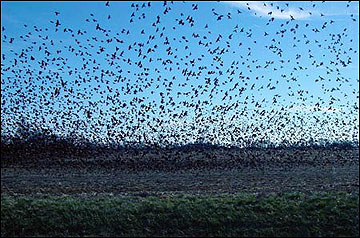 Figure 2
Figure 2
Millions of birds may gather to form winter roosts.
Managing bird roosts in urban areas
Blackbirds will begin to flock together during the late summer and may occupy suitable trees in a particular neighborhood, forming summer roosts. Many of these urban roosts contain a relatively small number of blackbirds which may choose to roost in a particular tree or area for a short period of time. Although the birds often move from these roosts when the leaves begin to fall, a homeowner may wish to move the roosts before economic damage or health problems occur. In these situations, prevention and control programs are often designed to move the birds to a place where damage, annoyance and threats to human health are minimal. Sparrows can present special problems, but sparrows roosting in trees or shrubs respond to control programs in much the same manner as other birds.
Birds seem to prefer trees and shrubs with dense branches. Cedars, pine plantations, hedges and deciduous shade trees that have been severely trimmed and have since developed a dense canopy are often selected as roosting sites.
How to move roosts in urban areas
Loud sounds
The most effective way to move bird roosts is through the use of sound. Sharp, loud noises are more effective than loud, sustained sounds. Banging metal pans or garbage can lids, beating a metal tub, striking a bell or slapping two boards together are a few ways to generate a suitable sound. Sustained production of this type of sound will usually succeed in moving the birds. Use innovative methods to produce the sound — for example, bells, cans containing rocks, or metal pans hung at 10- to 20-foot intervals on a rope that is strung through a hedge create sharp noises when one end of the rope is pulled.
Firing projectiles such as shellcrackers or shellbangers (pyrotechnics) is especially effective, although the cost per shot is relatively high. However, because these projectiles explode in the air where the birds are, relatively few are needed. Firing shotgun shells is much less expensive and also effective but is generally not recommended to control bird roosts in urban areas. Many areas have ordinances prohibiting the discharge of firearms, so check local laws before using this control method.
Distress calls
Recordings of starling distress calls have been used successfully to move starling roosts in urban areas. Such recordings must be played at a high volume for several consecutive evenings. The sound may need to be amplified if the trees or roosts are large.
Broadcast alarm notes of red-winged blackbirds, grackles, starlings and robins have also been used successfully to move roosts of these species. House sparrows have not been as responsive to broadcast alarm sounds as have the other species. Explosive sounds, such as those produced by shotgun shells, shellcrackers and shellbangers, increase the effectiveness of the broadcast alarm and distress calls but may not be a feasible option to use around the home. USDA APHIS–Wildlife Services can provide additional information on use of distress calls for controlling blackbird roosts.
Strategies for urban bird control
Community organization is necessary when using scare devices to disperse bird roosts in urban or suburban areas. If a summer roost has formed in the same area for several years, make plans to act in the spring or early summer before the birds arrive. The goal is to cause the birds to move to rural areas where they generally will not be an annoyance or cause an economic problem.
Public relation efforts should precede an urban bird-frightening effort. Follow these steps to educate the public and implement a program to disperse birds with scare devices:
- Consult with neighbors to find out if they agree on the problem.
- Contact local authorities such as the city manager, police department or health department for assistance. These officials can help explain the reasons for attempting to relocate the birds.
- Obtain the necessary equipment: a portable tape or CD player with amplifier, recordings of distress calls, pistol launchers with the appropriate pyrotechnics.
- Organize public employees or other responsible adults to help. Usually three or more people are needed, depending on the size of the roost.
- Schedule activities for at least four consecutive evenings.
- Begin dispersal activities two to three hours before dark, or as soon as the birds begin settling into the roost; continue until dark.
When birds first arrive at a roost, they may perch in nearby trees and fly around without settling. This behavior is referred to as “staging” and may continue for 15 to 30 minutes before birds begin to roost. Often, flocks of 500 to 600 birds stage together in a tree or two and move on to their roost just before dark. This behavior occurs every day at a particular roost site, whether it is a temporary roost or a more permanent site.
Birds are much easier to frighten while they are flying. A common error in bird roost control is to wait until the birds have settled into the roost before attempting to move them. The control program should be put into operation when the first birds begin arriving at the roost in the afternoon or late evening and should continue as long as the birds attempt to enter the roost. Every effort should be made to keep the birds from settling down in the roost. Begin playing distress calls, loudly and intermittently at first, and then continuously as most of the birds are entering. Move the player to various locations within the roost every few minutes. If projectiles can be used, shooters should fire over the tops of the roost trees. Whistle bombs fired into the incoming flocks will help turn them back.
Continue as long as birds are entering the roost or until nightfall. The first few nights, the birds may settle into the roost despite continued harassment. When this occurs, discontinue all control measures until the next evening.
Persist in your efforts on successive evenings. In large roosts or where roosts are well established, the first scare attempt may appear to be unsuccessful. Scaring may have to be continued for up to a week before the birds abandon the area. In small roosts or where birds are less well established, scaring may disperse flocks after the first two or three consecutive evenings. After the birds have moved, continue to observe the roost because a few birds may attempt to return. Repeating the control program for a brief period will keep the birds from reestablishing themselves in the roost.
Where dispersed flocks go is unpredictable. They may join flocks of birds going to other roosts or set up a new one. However, birds that have been moved are usually more responsive to dispersal from other sites.
Removing vegetation can be effective in controlling roost populations. Removing all cover is not always possible or desirable, but thinning helps. Wherever possible, remove all understory shrubs and brush, and discourage the development of interlocking canopy tree branches.
Winter bird roosts
Many blackbirds migrate farther south, but sizable flocks of grackles, brown-headed cowbirds, red-winged blackbirds and starlings remain in Missouri during the winter, especially in the southern and southeastern counties. After deciduous trees lose their leaves, flocks may assemble in conifers and hedgerows to take advantage of the protective cover of the closely spaced trees. An extremely large number of birds may inhabit winter roosts, which thus require a much larger area. These roosts are formed in much the same way as summer roosts are formed; flocks of birds may stage in nearby areas or may fly directly to the roosting site in the late evening. Winter roosts may persist from late fall until the following March.
Generally, winter roosts are located in more rural areas where they do not create the problems associated with summer and fall urban roosts, even though the roosts may comprise many more birds and cover larger areas. However, when winter roosts do become a problem, they can be extremely difficult to move. Although the same methods and equipment may be used to eliminate both summer and winter roosts, winter roosts require more persistence, more work, more assistance and more equipment, including shellcrackers and shellbangers with greater range than those used in urban areas.
Thinning may open the stands of trees enough to reduce their attractiveness as roosting sites. If the problem is severe, however, and winter roosts cannot be managed by bird-dispersal techniques, you need to consider timber harvests.
Winter bird roosts on structures
Starlings remaining in urban areas during the winter may roost overnight on building ledges, windowsills and other places where their noise may be objectionable and their droppings may deface buildings. They forage on streets, in vacant lots and around trash receptacles where food waste is carelessly scattered. They also feed at urban and suburban bird feeders.
Long-term solutions
The best long-term solution to roost problems on buildings is to alter the structure to prevent the birds from landing. When the roosting surface is a ledge, try placing a metal covering or board over the ledge at a minimum 45-degree angle (Figure 3a). Be sure to block the ends so birds cannot get beneath the board.
Another method of deterring birds from a ledge is to install “porcupine wire” or “bird spikes” (Figure 3b). These devices have short, heavy wire prongs that stick out at various angles to prevent birds from landing. You can buy these bird repellents or make them with coat hangers. To make them, cut six 6-inch lengths of coat hanger, bundle them and attach them securely to a block of wood or directly to the surface to be protected. Bend the wires so they stick out like cactus spikes. Place as many spikes as necessary on each window sill or ledge. Note, however, that this repellent is not always effective; pigeons have been seen building nests on wires, and starlings have been seen roosting on them.
A good solution to roost problems on rafters is to place plastic or nylon bird netting on the underside of rafters or ledges (Figure 4a). Netting is also useful for covering windows or other building openings. High-value trees may also be covered individually with netting to prevent birds from using the trees (Figure 4b).
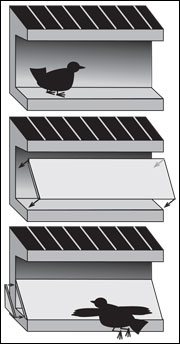 Figure 3
Figure 3
Deter birds from roosting on ledges by (a) increasing the angle of the ledge to at least 45 degrees
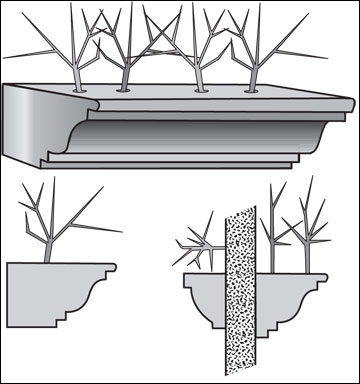 or (b) installing heavy wire prongs called porcupine wire or bird spikes.
or (b) installing heavy wire prongs called porcupine wire or bird spikes.
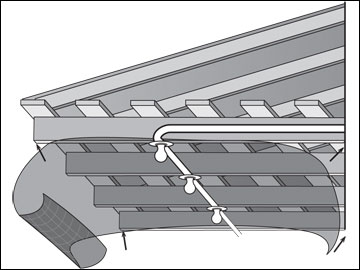 Figure 4
Figure 4
Netting can prevent birds from roosting (a) in rafters
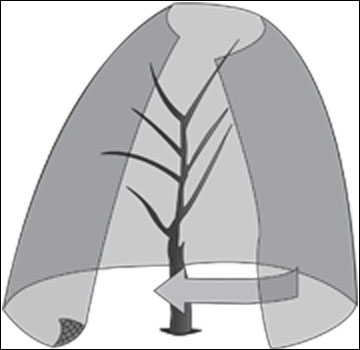 or (b) valuable trees.
or (b) valuable trees.
Short-term solutions
One solution commonly used by homeowners to address roost problems is a sticky repellent — a soft, nontoxic material that discourages roosting. These polybutenes, found under a variety of trade names, can provide an effective means of discouraging birds from roosting but are messy, collect dust and dirt, and must be reapplied several times a year. To increase the repellent’s effectiveness on porous surfaces and make removal easier, place masking tape on the surface needing protection and apply the repellent directly to the masking tape. Sticky repellents may not work well for house sparrows, which need only a small space on which to cling while roosting. The best way to discourage sparrows from roosting on structures is to use netting.
Distress calls and scare devices rarely prevent birds from roosting on structures. If you decide to use scare devices such as phony owls, string-tethered balloons, aluminum pie tins, plastic wind turbines, flashing lights or loud noise as a deterrent, move the devices to a new location every day. The simultaneous use of visual scare devices and noisemakers seems to be more effective in dispersing birds. However, distress calls and scare devices are seldom successful in dispersing starling flocks from structures.
Bird control assistance
For more information on preventing and controlling nuisance bird roosts, contact your local MU Extension center. For technical assistance controlling nuisance bird roosts, contact:
- USDA APHIS–Wildlife Services
1714 Commerce Court, Suite C
Columbia, MO 65202
573-449-3033
aphis.usda.gov/wildlife-services/publications/technical
Additional information
- Internet Center for Wildlife Damage Management, icwdm.org/
- Missouri Department of Conservation, mdc.mo.gov/
- USDA APHIS–Wildlife Services, aphis.usda.gov/wildlife-services